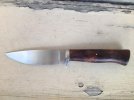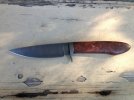Thanks for the list. It's a big help for beginners.
By any chance do you know a bit more about Sandalwood?
I didn't know it's so hard to come by since I got a few small sandalwood souvenirs from India the last couple of years.
After reading here its hard to get I tried to see if there are any Indian laws and it seems it's not allowed in some areas, in the south however it's even grown and farmed sustainably and then there can also be restrictions on how big an individual piece can be. It could even be that raw blanks arent up for sale and only artistic work can be purchased (might be some Indian states law to support local artists). Talk about complicated.
The small souvenirs I have look very creamy of a uniform color and smell very good. The surface is very smooth. Grains are probably very small and it looks like it wouldn't crack or shrink and expand much under adverse conditions. (Just guessing)
In case I am able to get a sufficiently big and legal piece (maybe even decorated), this summer when I travel the South, how would you work it into a knife handle.
Thank you.




